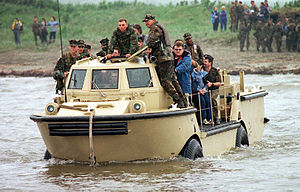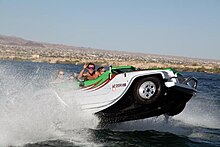Understanding the Features Of Water Cars And Their Advantages/Disadvantages
The technology behind water cars otherwise known as amphibious vehicles had never been an easy one. It has to do with principles of flotations and motions put together. When engineers came up with the idea of water cars in 1770.
The invention was credited to Prince Raimondo who built the first amphibious carriage and Samuel Bentham whose design was built in 1787, all these engineers actually knew it is very possible.
However, the possible technical problems remained regarding how leaking can be prevented and the floating possibilities of such vehicles to reduce the risk of sinking in water when faced with storms or other negative forces.
By definition, water cars or amphibious vehicles are transportation vehicles meant to run on land and on water.
The vehicles can run at full speed on land like conventional cars and still have the ability to move into the water with the loads in it and run on the water like a speedboat or as the ship would do.
Ever since its invention in 1770, the technology has not become popular even though it was invented years ago like other existing technologies and the reason is that the use of such vehicle has not become a necessity to civilians but to the military, it is a different thing as the vehicle was seen as a good idea that can help increase the mobility of the military and enhance their operations in both land and water.
Amphibious vehicles or water cars meant for civilian use have been classified to include; water power bicycles and bikes, amphibious speed cars, water buses, water trucks, land boats, etc. these vehicles can carry a good amount of load or humans and run smoothly on land and water and vice versa.
The use of such vehicles has become an option for those living close to waterfronts due to the possibility of driving them directly from home into the water, running through the waterways to their destination, and returning home with the vehicle without packing it at the waterfront which is an important aspect in securing their property that cannot be obtainable in ordinary boats or ships.
Despite the scarce use, the military had earlier inventions that dominated the civilians in the use of the amphibious vehicles (Water Cars). Some of the popular Water Cars (amphibious vehicles) made so far belong to the military or can be said that they were meant for military use, some examples of such vehicles include;

Ekranoplans,
Hovercrafts,
LARC-V5 amphibious cargo vehicles,
Jet-propelled amphibious boats like the French VAB,
Amphibious alligator tug, water land rover,
And LVT buffalos in Canada, etc.
The military has been developing and using these vehicles to aid their operations since its invention.
However, the sizes, brand, and quality of the military designs have been found to be according to the type of operation and nature.
Also, military from different countries had been found to develop their own military amphibious cars based on their own specifications.
The recent research also showed that almost all the modern commercial military vehicles including armored personnel carriers, tanks, warfare ships, etc. were built with amphibious capabilities.

DISADVANTAGES OF WATER CARS/AMPHIBIOUS VEHICLES
Despite the features of water Cars and their advantages, such amphibious vehicles had been found to possess the following setbacks:
- Some amphibious vehicles have slow speeds while on water because of the resistance created by the tires below them.
- They may have limitations as to the depth of water they can be used.
- There is a greater risk of sinking than conventional boats made with fiber because they are bulky, bear tires, and made with metals.
- They cannot be used to chase conventional boats on the water, meaning they may not be able to chase criminals operating in waterways.
- They may be consuming more fuel while on the water than normal boats due to their weight and slow speed.
- They may not be good for water that has storm conditions or severe wind, except if the water depth is very shallow.
- If the propelling engine gets damaged while on water, that may become a serious problem.
ADVANTAGES OF WATER CARS/AMPHIBIOUS VEHICLES
Despite all the setbacks, the Water Cars (amphibious cars) have the following advantages:
- They enhance the speed of military operations on land and water.
- The vehicles are usually strong to withstand different weather conditions.
- They are usually equipped with long-range machine guns, etc. for distance operations.
- The majority of them are bulletproof cars.
- They can carry a substantial amount of loads including military personnel.
- They can be highly resistant to water leakages at their base than conventional boats.
- When hit by a solid object below the water, it leaves no damage to the vehicle body and the impact force may be low due to their bulky nature.
More Facts Regarding Water Car Advantages and Disadvantages
Though the above features of water cars and their advantages and disadvantages were generalized, some may be omitted or added depending on the type of the military amphibious vehicle.
Research showed that some amphibious vehicles (water cars) had been designed to operate more efficiently on the water than land, while some were made to operate more efficiently on land than water.
Any of the above choices of a design was based on the supposed functions of the amphibious vehicle (water Car) so in such case, the disadvantages and advantages may vary.

Light tanks like the US PT-76, can operate both on land and in water. It is an amphibious vehicle equipped with sets of hydro jets.
The question of having a vehicle that can completely be inside water or fully covered with water like submarines and still is moving or carrying out its operations may not be answered currently, though possibly more information will be gathered about such before its features publication.

Conclusion
Thank you for reading, use the comment section to give us feedback regarding how useful this post is in regard to your expected areas of coverage. This will enable us to improve on this topic.
